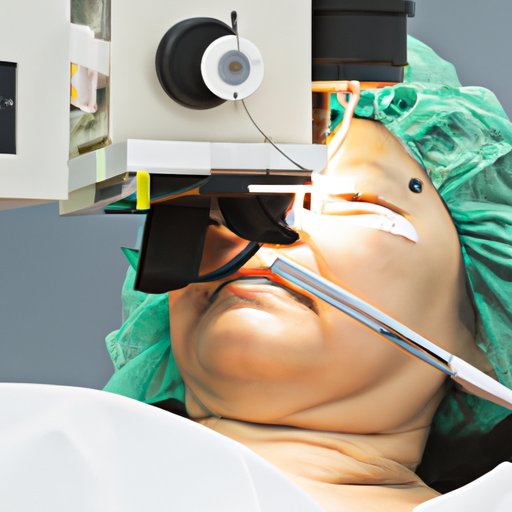Introduction
Patricia Bath is a renowned scientist, doctor, and inventor whose work has revolutionized the field of ophthalmology. She was the first African-American female doctor to receive a medical patent for her invention, the Laserphaco Probe, which made cataract surgery quicker and more effective. In this article, we will explore the life and accomplishments of Patricia Bath, as well as the impact of her invention on eye care and ophthalmology research.

A Biography of Patricia Bath: Exploring the Life and Inventions of This Pioneering Ophthalmologist
Patricia Bath was born in Harlem, New York in 1942. She was raised in a family of educators and was encouraged by her parents to pursue a career in science. She attended Hunter College High School and went on to graduate from New York University with a degree in chemistry. She then earned her medical degree from Howard University, becoming one of the first African-American women to do so.
Bath began her career as an ophthalmologist at the UCLA Medical Center, where she quickly established herself as a leader in the field. As a professor of ophthalmology at UCLA, she conducted groundbreaking research on blindness prevention and treatments. She also founded the American Institute for the Prevention of Blindness, an organization dedicated to reducing preventable blindness in underserved communities around the world.
In 1986, Bath made history when she became the first African-American woman to receive a medical patent for her invention, the Laserphaco Probe. The device revolutionized cataract surgery, making it much faster and more precise. It was a major breakthrough in the field of ophthalmology and has since been used to treat millions of patients worldwide.

The Revolutionary Invention of Patricia Bath: How Laserphaco Cataract Surgery Changed the World
The Laserphaco Probe is a device that uses ultrasonic energy to break up and remove cataracts from the eye. It is a minimally invasive procedure that can be completed in a matter of minutes, compared to the hours-long process of traditional cataract surgery. The device consists of a handheld probe that is inserted into the eye, where it emits ultrasonic waves that break up the cataract and suction it out of the eye.
The procedure begins with numbing the eye and injecting a special solution into the eye to soften the cataract. The surgeon then inserts the probe and activates its ultrasonic energy, which breaks up the cataract into small fragments that can be easily removed. Once the cataract is removed, the surgeon replaces it with an artificial lens to restore vision.
The benefits of this procedure are numerous. Most notably, it is much less invasive than traditional cataract surgery, which requires a large incision and a longer recovery time. Additionally, laserphaco cataract surgery is much faster, allowing patients to get back to their normal activities much sooner. Finally, it is much more affordable than traditional cataract surgery, which makes it accessible to more people.
Exploring the Impact of Patricia Bath’s Invention on Eye Care
Patricia Bath’s invention has had a profound impact on eye care. Before the development of the Laserphaco Probe, cataract surgery was a lengthy, expensive, and risky procedure. With the introduction of this device, cataract surgery has become much safer and more accessible. Here are some of the ways Patricia Bath’s invention has improved eye care:
- Increased Access to Quality Eye Care: By making cataract surgery more affordable, Patricia Bath’s invention has enabled more people to access quality eye care. This has been especially beneficial for those living in low-income countries, where access to quality eye care is often limited or unavailable.
- Improved Outcomes: The accuracy and precision of the Laserphaco Probe have resulted in improved outcomes for patients. Studies have shown that the device produces better visual acuity and fewer complications than traditional cataract surgery.
- Reduced Costs: Since the Laserphaco Probe is less invasive and takes less time to perform, it has helped reduce the cost of cataract surgery. This has enabled more people to afford the procedure, thus improving access to quality eye care.
Uncovering the Legacy of Patricia Bath: How Her Invention Helped Improve Sight
Before the invention of the Laserphaco Probe, cataract surgery was a difficult and dangerous procedure. It required a large incision and a long recovery period. Additionally, the results were often unpredictable and unsatisfactory. But with the introduction of Patricia Bath’s device, cataract surgery has become much safer and more effective. Here’s a look at the history of cataract surgery before and after the invention of the Laserphaco Probe.
Before the invention of the Laserphaco Probe, the most common method of cataract surgery was called intracapsular cataract extraction (ICCE). This procedure involved making a large incision in the eye and manually removing the entire cataract. The procedure was time-consuming and often resulted in poor outcomes. Furthermore, the risks of infection and other complications were high.
With the introduction of the Laserphaco Probe, cataract surgery has become much easier and safer. The device allows surgeons to break up and remove cataracts with minimal invasion and greater precision. The procedure is much faster and produces better visual outcomes. Additionally, the risks of infection and other complications are much lower.
The Science Behind Patricia Bath’s Laserphaco Cataract Surgery
The Laserphaco Probe is a remarkable device that combines physics, chemistry, and biology to produce a quick, safe, and effective cataract surgery. Here’s a look at the science behind this revolutionary invention.
- Development of the Laserphaco Technology: The Laserphaco Probe was developed by combining existing technologies, such as lasers and ultrasound. The device uses an infrared laser to break up the cataract, while an ultrasound probe is used to suction out the fragments.
- The Role of Physics: Physics plays a crucial role in the operation of the Laserphaco Probe. The device uses an infrared laser to break up the cataract, while an ultrasound probe is used to suction out the fragments. Additionally, the device utilizes Newtonian mechanics to keep the probe stable during surgery.
- The Role of Chemistry: The device also uses a special solution to soften the cataract and make it easier to break up. This solution is composed of various chemicals, such as sodium chloride and potassium chloride, which dissolve the proteins in the lens and make it easier to remove.
- The Role of Biology: Biology is also essential to the success of the Laserphaco Probe. The device is designed to be minimally invasive and cause minimal damage to the eye, thus reducing the risk of infection or other complications.

Celebrating the Achievements of Patricia Bath: Recognizing a Groundbreaking Woman in STEM
Patricia Bath’s achievements have been widely celebrated by the scientific community. She has been honored with numerous awards and honors, including the National Medal of Technology and Innovation. She has also been recognized for her cultural significance, as her work has inspired countless young women to pursue careers in STEM.
- Awards and Honors: Patricia Bath has received numerous awards and honors for her achievements. These include the National Medal of Technology and Innovation, the National Science Foundation’s Alan T. Waterman Award, and the Albert Lasker Medical Research Award.
- Cultural Significance: Patricia Bath’s work has also been celebrated for its cultural significance. Her story has inspired countless young women to pursue careers in STEM, proving that anything is possible with hard work and dedication.
Examining the Role of Patricia Bath in Advancing Ophthalmology Research
Patricia Bath’s work has had a lasting impact on ophthalmology research. Her invention of the Laserphaco Probe revolutionized cataract surgery, enabling more people to access quality eye care. Additionally, her research on blindness prevention and treatments has advanced the field of ophthalmology and helped improve sight for many people.
- Contributions to Ophthalmology: Patricia Bath’s contributions to ophthalmology are numerous. Her invention of the Laserphaco Probe revolutionized cataract surgery, making it much faster and more accurate. Her research on blindness prevention and treatments has also advanced the field of ophthalmology and improved sight for many people.
- Ongoing Research: Patricia Bath’s research continues to be influential in the field of ophthalmology. Her work has inspired numerous studies on blindness prevention and treatments, as well as the development of new technologies to improve eye care.
Conclusion
Patricia Bath is a pioneering ophthalmologist whose invention of the Laserphaco Probe revolutionized cataract surgery. Through her groundbreaking research and inventions, she has improved eye care and reduced costs, making it more accessible to people around the world. Her work has also inspired countless young women to pursue careers in STEM, proving that anything is possible with hard work and dedication.
Patricia Bath’s legacy will continue to live on through her contributions to ophthalmology research. Her work has improved sight for millions of people, and her invention of the Laserphaco Probe will continue to benefit patients for years to come. She is a true pioneer in the field of ophthalmology and a role model for aspiring scientists everywhere.
(Note: Is this article not meeting your expectations? Do you have knowledge or insights to share? Unlock new opportunities and expand your reach by joining our authors team. Click Registration to join us and share your expertise with our readers.)
